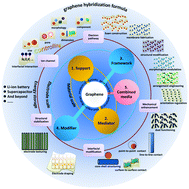当前位置:
X-MOL 学术
›
Chem. Soc. Rev.
›
论文详情
Our official English website, www.x-mol.net, welcomes your feedback! (Note: you will need to create a separate account there.)
Graphene hybridization for energy storage applications
Chemical Society Reviews ( IF 46.2 ) Pub Date : 2018-03-07 00:00:00 , DOI: 10.1039/c7cs00871f Xianglong Li 1, 2, 3, 4, 5 , Linjie Zhi 1, 2, 3, 4, 5
Chemical Society Reviews ( IF 46.2 ) Pub Date : 2018-03-07 00:00:00 , DOI: 10.1039/c7cs00871f Xianglong Li 1, 2, 3, 4, 5 , Linjie Zhi 1, 2, 3, 4, 5
Affiliation

|
Graphene has attracted considerable attention due to its unique two-dimensional structure, high electronic mobility, exceptional thermal conductivity, excellent optical transmittance, good mechanical strength, and ultrahigh surface area. To meet the ever increasing demand for portable electronic products, electric vehicles, smart grids, and renewable energy integrations, hybridizing graphene with various functions and components has been demonstrated to be a versatile and powerful strategy to significantly enhance the performance of various energy storage systems such as lithium-ion batteries, supercapacitors and beyond, because such hybridization can result in synergistic effects that combine the best merits of involved components and confer new functions and properties, thereby improving the charge/discharge efficiencies and capabilities, energy/power densities, and cycle life of these energy storage systems. This review will focus on diverse graphene hybridization principles and strategies for energy storage applications, and the proposed outline is as follows. First, graphene and its fundamental properties, followed by graphene hybrids and related hybridization motivation, are introduced. Second, the developed hybridization formulas of using graphene for lithium-ion batteries are systematically categorized from the viewpoint of material structure design, bulk electrode construction, and material/electrode collaborative engineering; the latest representative progress on anodes and cathodes of lithium-ion batteries will be reviewed following such classifications. Third, similar hybridization formulas for graphene-based supercapacitor electrodes will be summarized and discussed as well. Fourth, the recently emerging hybridization formulas for other graphene-based energy storage devices will be briefed in combination with typical examples. Finally, future prospects and directions on the exploration of graphene hybridization toward the design and construction of viable, high-class, and even newly-featured (e.g., flexible) energy storage materials, electrodes, and systems will be presented.
中文翻译:

石墨烯杂交技术在储能应用中的应用
石墨烯因其独特的二维结构,高电子迁移率,出色的导热性,出色的透光率,良好的机械强度和超高表面积而备受关注。为了满足对便携式电子产品,电动汽车,智能电网和可再生能源集成的不断增长的需求,将石墨烯与各种功能和组件进行混合已被证明是一种通用且强大的策略,可以显着提高各种储能系统的性能,例如作为锂离子电池,超级电容器及其他电容器,因为这种杂交可以产生协同效应,将相关组件的最佳优点结合在一起并赋予新的功能和特性,从而提高充电/放电效率和功能,能量/功率密度,以及这些储能系统的循环寿命。这篇综述将集中在用于储能应用的各种石墨烯杂交原理和策略上,提出的概述如下。首先,介绍了石墨烯及其基本特性,然后介绍了石墨烯杂化体和相关的杂化动机。其次,从材料结构设计,体电极结构和材料/电极协同工程的角度对系统开发的石墨烯用于锂离子电池的混合式进行了系统分类。按照此类分类,将对锂离子电池正极和负极的最新代表性进展进行回顾。第三,还将概述和讨论基于石墨烯的超级电容器电极的类似杂交公式。第四,将结合典型示例简要介绍其他基于石墨烯的储能设备的最新出现的混合公式。最后,关于石墨烯杂化探索的未来前景和方向,以设计和构建可行,高级甚至是新功能的石墨烯(将展示例如柔性的能量存储材料,电极和系统。
更新日期:2018-03-07
中文翻译:

石墨烯杂交技术在储能应用中的应用
石墨烯因其独特的二维结构,高电子迁移率,出色的导热性,出色的透光率,良好的机械强度和超高表面积而备受关注。为了满足对便携式电子产品,电动汽车,智能电网和可再生能源集成的不断增长的需求,将石墨烯与各种功能和组件进行混合已被证明是一种通用且强大的策略,可以显着提高各种储能系统的性能,例如作为锂离子电池,超级电容器及其他电容器,因为这种杂交可以产生协同效应,将相关组件的最佳优点结合在一起并赋予新的功能和特性,从而提高充电/放电效率和功能,能量/功率密度,以及这些储能系统的循环寿命。这篇综述将集中在用于储能应用的各种石墨烯杂交原理和策略上,提出的概述如下。首先,介绍了石墨烯及其基本特性,然后介绍了石墨烯杂化体和相关的杂化动机。其次,从材料结构设计,体电极结构和材料/电极协同工程的角度对系统开发的石墨烯用于锂离子电池的混合式进行了系统分类。按照此类分类,将对锂离子电池正极和负极的最新代表性进展进行回顾。第三,还将概述和讨论基于石墨烯的超级电容器电极的类似杂交公式。第四,将结合典型示例简要介绍其他基于石墨烯的储能设备的最新出现的混合公式。最后,关于石墨烯杂化探索的未来前景和方向,以设计和构建可行,高级甚至是新功能的石墨烯(将展示例如柔性的能量存储材料,电极和系统。



























 京公网安备 11010802027423号
京公网安备 11010802027423号